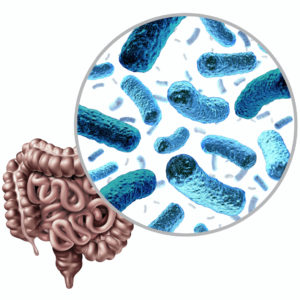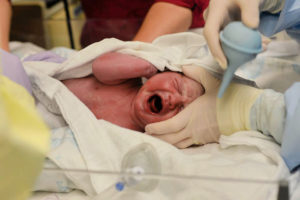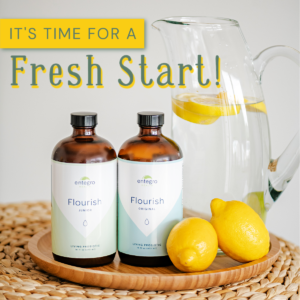Human Microbiome Through the Lifespan
Throughout the human lifespan, the body undergoes many changes to include everything from growth to aging.
 The human microbiome is not a static entity. Our many daily choices affect how and who grows in the gut throughout the lifespan. These include, but are not limited to:
The human microbiome is not a static entity. Our many daily choices affect how and who grows in the gut throughout the lifespan. These include, but are not limited to:
In addition to daily choices, the primary gut microbiomes naturally fluctuate throughout our lifespan, mostly natural and without harm. The largest changes occur during infancy and old age. Interestingly, these times of life are also when immune health is in its most unstable stage, which may show this two interact during the growth, development, and aging of humans.1
Infancy (0-1)
Vaginal delivery is sometimes referred to as the “bacterial baptism” of neonates. As babies are pushed into the world, they are exposed to the diverse array of mom’s bacteria on the way out. This normal vaginal delivery was originally thought to be baby’s first exposure to bacteria because the placenta was thought to be a sterile environment.

Recent studies have found that the microbiomes of infants delivered via C-section and vaginal delivery are very similar within the first three days of life. This suggests the original bacteria exposure happens in utero from mom. The current thinking is bacteria can travel from mom’s placenta, amniotic cavity, or umbilical cord to baby.1,2 Similar to the blood-brain barrier, the placenta acts as a physical barrier to the outside world via mom’s immune system. This idea of bacteria crossing, in part or in whole, or the metabolites they produce is not well studied in humans for safety and ethical reasons. However, several studies in mice can help guide our thinking.
Continued Debate of Modern Science
The study performed by Mueller et. al took two groups of sterile pregnant mice. One-half of the mice were then colonized with healthy bacteria. The pups of the colonized mamas were found to have an increased amount of certain innate immune cells.3,4
Other studies suggest otherwise – that placenta remains a bacteria-free environment.5 This topic is controversial in the world of where the human microbiome originates from. Although some may find it discouraging, it shows what an exciting time in science we are in. We’re just scratching the surface of an intrepid new world with so many possibilities to further our understanding and application.
Regardless of how the microbiome is first inoculated by bacteria, infant gut microbiomes change quickly as they undergo many new firsts. Their little gut microbiomes are influenced by breastmilk, formula, probiotic and antibiotic use, the addition of solid foods, and even family pets.1 Doing small things to support baby gut microbiomes can make a lifespan difference.
The live, liquid nature of Flourish makes flexible dosing very easy for all ages, especially babies.
Childhood (2-puberty)
Childhood is years of rapid growth in body, mind, and gut bacteria. Studies have shown the microbiome of children to be more adaptable and moldable than adults.5 This is encouraging to women and children who were not able to deliver vaginally. Being intentional to expose and develop the gut microbiome can have a positive lifelong influence.
Emerging research is showing the importance of the microbiome to the development of the immune and nervous system, and even the growth of children.6 Mindful avoidance of gut disruptors such as unnecessary antibiotic use, lack of sleep, or a low fiber diet can make a big difference in a child’s gut.
Communication and guidance at the various stages of childhood, adolescents, and puberty can be challenging in some areas at some stages, and easier at others.

Encouraging a 12-year-old to try the fiber-rich foods on her plate may be easier than offering a threenager anything green. Guiding a teenager (a notorious age known for the erratic and low priority sleep schedule) to get sufficient sleep may prove more challenging than putting a five-year-old to bed. Perfectly supporting a child’s gut microbiome is not possible. Just do the best you can with the resources you have. And thank goodness childhood gut microbiomes are resilient and adaptable. Repeated efforts to develop healthy habits may feel like beating your parent head against the wall at times, but how many of us find we turn into our parents as we age? Demonstrating gut-friendly habits is the one certain way to teach when all else feels like it’s not getting through.
Flourish is a great support to the gut microbiome during this developmental time of the lifespan. Flourish is kept in its most natural state after being fermented because that’s the way the bacteria prefer to live, and it’s filled with beneficial metabolites produced during growth. For that reason, most American palates are not familiar with a fermented flavor. It may take some time to get used to. If the flavor is a challenge, many customers have success mixing the living probiotic in juice until they get used to the flavor. Or simply because that’s the way they prefer to take it.
Adulthood (puberty-64)
The largest of the categories, adulthood begins after puberty until the age of 64. Defining what a healthy gut microbiome is can be a challenge because natural similarities and variances can be distinguished by geographical location, culture, socioeconomic status, history of breastfeeding, gender, mental health history, BMI, and even pet choices. Every person’s gut microbiome looks quite different. Therefore, the idea of balance is different for each individual. Describing an unhealthy gut is far easier because it’s not working as it should be. Signs include gas, bloating, constipation, diarrhea, heartburn, and much more. Even things that don’t seem directly linked, such as some skin issues or even more significant and difficult to study, the gut-brain connection.

Stress is one of the largest negative influencers of this age time frame.
A lot of life happens over these nearly 50 years. School, career decisions, relationships, caring for children, and elderly parents, all while making ends meet is a challenge. Research is showing that stress not only alters intestinal mucosa permeability – think leaky gut – but may also significantly change the community structure and activity of the bacteria found in the gut. And because of the bidirectional interaction of the gut-brain axis, gut microbiota may influence stress-related physiologic responses.7,8
Taking care of the gut during this time frame can make a difference as we approach the elderly phase of life. Learn more about how to get the most out of your gut health here.
Elderly (65+)
The golden years can be a beautiful stage of the lifespan with family and friends or working at the peak of a career. In the advanced golden age, the cumulative effects of aging are more prominently seen, or perhaps more accurate – felt. The medical term of aging is associated with the decline of multiple bodily functions as well as inflammation. This is believed to lead to the onset of frailty, or being more vulnerable to disease and challenges to everyday stressors.

Frailty is associated with changes in the gut microbiota that may be linked to a less diverse diet whether that be due to dietary restrictions or access to high-quality food. In old age, the altered gut diversity and depleted gut barrier may bother the bacteria and therefore the valuable metabolites they produce. This alteration may begin the inflammatory responses eventually affecting the gut-brain communication. It remains to be seen whether the changes in the gut and the hallmarks of aging influence the immune function of the gut or if the compromised nature of the gut causes the reduction in immune function.1
Support Through the Lifespan
Supporting the gut microbiome and lining is of great value during these years of the lifespan. Flourish has a diverse profile of eleven strains from five different families that grow and live together.

No matter the age, maintaining a healthy gut can have far-reaching benefits throughout the body. As science is just scratching the surface of this wild and brave new world of the human gut microbiome, we look forward to advancements that will allow us to better understand the nuances in caring for the whole person and all the microbes that live there.
Written by Lorilyn Van Dyke, Entegro Health
Sources
- Nagpal, R., Mainali, R., Ahmadi, S., Wang, S., Singh, R., Kavanagh, K., Kitzman, D. W., Kushugulova, A., Marotta, F., & Yadav, H. (2018). Gut microbiome and aging: Physiological and mechanistic insights. Nutrition and healthy aging, 4(4), 267–285. https://doi.org/10.3233/NHA-170030
- Stinson, LF, et al. “A Critical Review of the Bacterial Baptism Hypothesis and the Impact of Cesarean Delivery on the Infant Microbiome.” Frontiers in Medicine, vol. 5, no. 135, 4 May 2018, doi:10.3389/fmed.2018.00135.
- Gomez De Aguero, M., Ganal-Vonarburg, S. C., Fuhrer, T., Rupp, S., Uchimura, Y., Li, H., . . . Macpherson, A. J. (2016). Science, 351(6279), 1296-1302. doi:10.1126/science.aad2571
- Juanita BawaganJul. 31, 2., Paul VoosenNov. 17, 2., Jocelyn KaiserNov. 16, 2., Jon CohenNov. 16, 2., Warren CornwallNov. 13, 2., Jon CohenNov. 11, 2., . . . Lucy HicksOct. 20, 2. (2019, July 31). Babies get critical gut bacteria from their mother at birth, not from placenta, study suggests. Retrieved November 13, 2020, from https://www.sciencemag.org/news/2019/07/bacteria-free-placentas-suggest-babies-pick-microbiome-birth
- Mohammadkhah, A. I., Simpson, E. B., Patterson, S. G., & Ferguson, J. F. (2018). Development of the Gut Microbiome in Children, and Lifetime Implications for Obesity and Cardiometabolic Disease. Children (Basel, Switzerland), 5(12), 160. https://doi.org/10.3390/children5120160
- Gaufin, T., Tobin, N. H., & Aldrovandi, G. M. (2018). The importance of the microbiome in pediatrics and pediatric infectious diseases. Current opinion in pediatrics, 30(1), 117–124. https://doi.org/10.1097/MOP.0000000000000576
- Lach G, Schellekens H, Dinan TG, Cryan JF. Anxiety, depression, and the microbiome: a role for gut peptides. Neurotherapeutics. 2018;15(1):36-59. doi:10.1007/s13311-017-0585-0
- Cryan JF, O’Riordan KJ, Cowan CSM, et al. The microbiota-gut-brain axis. Physiol Rev. 2019;99(4):1877-2013. doi:10.1152/physrev.00018.2018

 New customers! Get 11% OFF your first Flourish order with Code FRESHSTART11
New customers! Get 11% OFF your first Flourish order with Code FRESHSTART11